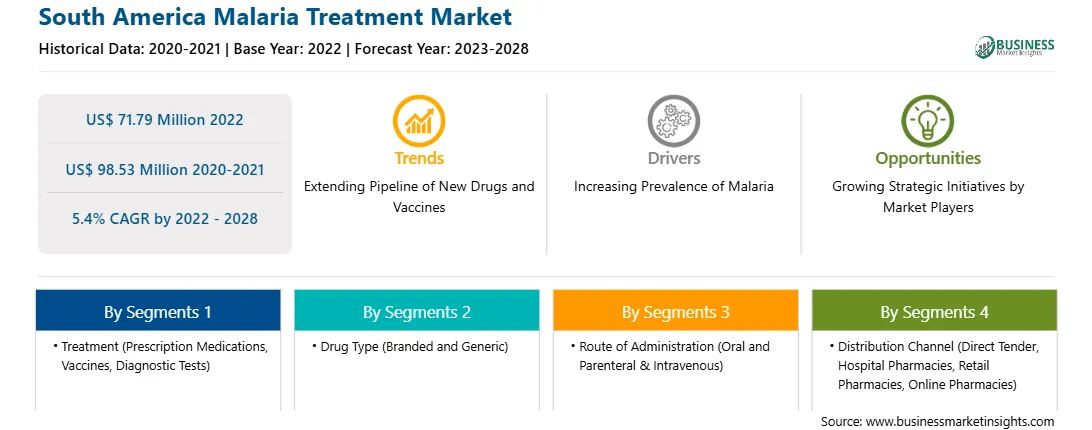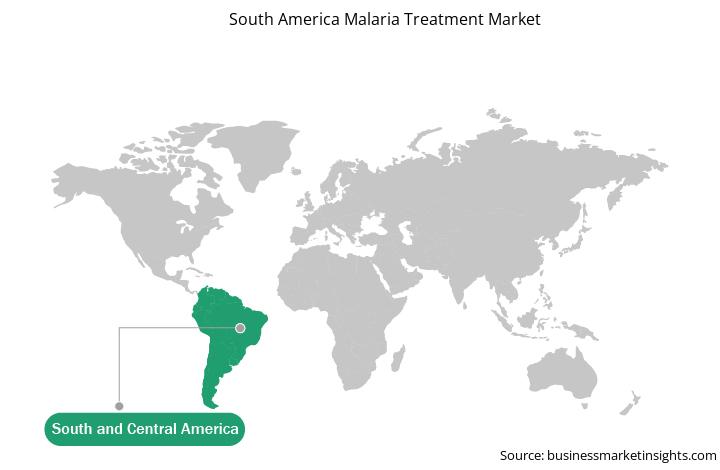Rapid Diagnostic Tests is Driving the South America Malaria Treatment Market
RDTs for malaria can improve the quality of management of the disease. RDTs are proven to be highly affordable and effective for public health programs implemented in low-resource settings. RDTs are widely used in remote areas with limited access to microscopy services. As a result, there has been a rapid rise in the demand for RDTs for malaria. Several RDTs have been developed to test the presence of malaria parasites in blood South Americaples. Identifying and successfully treating malaria in low transmission areas is critical to reduce transmission and achieve complete elimination of the disease. Many companies are engaged in developing a wide range of RDTs with high sensitivities. So, growing rapid diagnostic tests is expected to drive the South America malaria treatment market growth across the region.
South America Malaria Treatment Market Overview
The South America malaria treatment market is categorized into Brazil, Argentina, and the Rest of South America. Brazil held the substantial share in the market during forecast period. Malaria has always been a major public health concern in Brazil. The early history of malaria in Brazil and measures for its control has been powered by the forced relocation of Africans as enslaved people and the colonization of the Europeans. The immigrants brought malaria to different areas of Brazil. In Brazil, malaria is caused by three species of Plasmodium—P. vivax (which accounts for 83.7% of the registered cases), P. falciparum (causing 16.3% of the cases), and P. malariae (a small proportion of cases). The Brazilian government launched the National Malaria Elimination Plan, intending to reduce the number of local malaria cases to less than 68,000 by 2025 and the number of deaths to zero by 2030, as well as eliminate the disease in Brazil by 2035. Brazil is a country that houses the Amazon rainforest, from where most of the malaria cases come. Approximately 99.9% of transmissions in Brazil occur in the Amazon area and 80% in 33 cities.
In 2021, over 137.8 cases were reported. The Brazilian government is investing in treatment, pest control, and technical support to cities and states while also training personnel. The Elimination Plan will work through the Brazilian Unified Health System, based on free diagnosis and treatment, decentralized actions for diagnostic and wide coverage treatment, and using online information systems, multi-sector partnerships, and research networks. On October 30, 2019, GSK Brazil and MMV announced that the Brazilian Health Regulatory Agency (AVINSA) had granted the Marketing Authorization Approval under propriety review for the single dose tafenoquine for the medical cure of plasmodium vivax malaria in 16-year-old patients and for the older who are receiving chloroquine for the acute P. vivax infection. Jose Carlos Felner, the president of the GSK’s pharmaceutical division in Brazil, said that the approval of tafenoquine in the country is an important step in the fight against neglected diseases such as malaria. This will increase the demand for malaria treatment in Brazil and help eradicate the disease. Thus, the growing technical support by the Brazilian government can fuel the growth of the market.
Strategic insights for the South America Malaria Treatment provides data-driven analysis of the industry landscape, including current trends, key players, and regional nuances. These insights offer actionable recommendations, enabling readers to differentiate themselves from competitors by identifying untapped segments or developing unique value propositions. Leveraging data analytics, these insights help industry players anticipate the market shifts, whether investors, manufacturers, or other stakeholders. A future-oriented perspective is essential, helping stakeholders anticipate market shifts and position themselves for long-term success in this dynamic region. Ultimately, effective strategic insights empower readers to make informed decisions that drive profitability and achieve their business objectives within the market. The geographic scope of the South America Malaria Treatment refers to the specific areas in which a business operates and competes. Understanding local distinctions, such as diverse consumer preferences (e.g., demand for specific plug types or battery backup durations), varying economic conditions, and regulatory environments, is crucial for tailoring strategies to specific markets. Businesses can expand their reach by identifying underserved areas or adapting their offerings to meet local demands. A clear market focus allows for more effective resource allocation, targeted marketing campaigns, and better positioning against local competitors, ultimately driving growth in those targeted areas.South America Malaria Treatment Strategic Insights

South America Malaria Treatment Report Scope
Report Attribute
Details
Market size in 2022
US$ 71.79 Million
Market Size by 2028
US$ 98.53 Million
Global CAGR (2022 - 2028)
5.4%
Historical Data
2020-2021
Forecast period
2023-2028
Segments Covered
By Treatment
By Drug Type
By Route of Administration
By Distribution Channel
By End User
Regions and Countries Covered
South and Central America
Market leaders and key company profiles
South America Malaria Treatment Regional Insights

South America
Malaria Treatment Market Segmentation
The South America malaria treatment market is segmented based on treatment, drug type, route of administration, distribution channel, end user, and country.
Based on treatment, the South America malaria treatment market is segmented into prescription medications, vaccines, diagnostic tests, and others. The diagnostic tests segment held the largest market share in 2022. The prescription medications segment is further categorized into chloroquine phosphate, artemisinin-based combination therapies (ACTs), atovaquone-proguanil, quinine sulfate (qualaquin) with doxycycline, primaquine phosphate, and others.
Based on drug type, the South America malaria treatment market is bifurcated into branded and generic. The generic segment held a larger market share in 2022.
Based on route of administration, the South America malaria treatment market is bifurcated into oral and parenteral & intravenous. The oral segment held a larger market share in 2022.
Based on distribution channel, the South America malaria treatment market is segmented into direct tender, hospital pharmacies, retail pharmacies, online pharmacies, and others. The direct tender segment held the largest market share in 2022.
Based on end user, the South America malaria treatment market is segmented into hospitals, specialty clinics, homecare, and others. The hospitals segment held the largest market share in 2022.
Based on country, the South America malaria treatment market has been categorized into Brazil, Argentina, and the Rest of South America. Our regional analysis states that the Rest of South America dominated the market in 2022.
AdvaCare Pharma USA LLC, Cipla Ltd, GSK Plc, Lupin Ltd, Novartis AG, Sanofi SA, Sun Pharmaceutical Industries Ltd, Viatris Inc, and Zydus Healthcare Ltd are among the leading companies operating in the South America malaria treatment market.
The South America Malaria Treatment Market is valued at US$ 71.79 Million in 2022, it is projected to reach US$ 98.53 Million by 2028.
As per our report South America Malaria Treatment Market, the market size is valued at US$ 71.79 Million in 2022, projecting it to reach US$ 98.53 Million by 2028. This translates to a CAGR of approximately 5.4% during the forecast period.
The South America Malaria Treatment Market report typically cover these key segments-
The historic period, base year, and forecast period can vary slightly depending on the specific market research report. However, for the South America Malaria Treatment Market report:
The South America Malaria Treatment Market is populated by several key players, each contributing to its growth and innovation. Some of the major players include:
The South America Malaria Treatment Market report is valuable for diverse stakeholders, including:
Essentially, anyone involved in or considering involvement in the South America Malaria Treatment Market value chain can benefit from the information contained in a comprehensive market report.